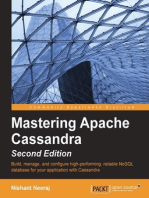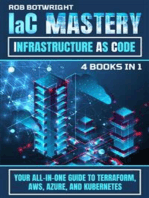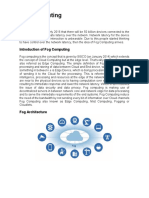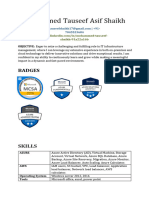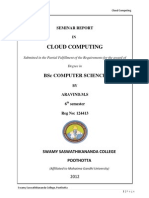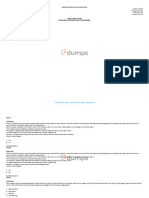Amazon Web Services Hyderabad
Amazon Web Services Hyderabad
Uploaded by
raghava KCopyright:
Available Formats
Amazon Web Services Hyderabad
Amazon Web Services Hyderabad
Uploaded by
raghava KCopyright
Available Formats
Share this document
Did you find this document useful?
Is this content inappropriate?
Copyright:
Available Formats
Amazon Web Services Hyderabad
Amazon Web Services Hyderabad
Uploaded by
raghava KCopyright:
Available Formats
✉ training@polyglotit.com www.polyglotit.
com ☎7285948228, 040-42305268
“AWS for Administrators”
What makes us unique
★ Industry experts
★ Real-time projects
★ Workshops on every weekend
★ Internship Programs
★ Job assistance up to 12 months
★ Placement Assistance Program(PAP)
Our address
Ameerpet
307/B,Nilgiri Block, Aditya Enclave, Ameerpet,Hyderabad-500038.
Polyglot IT Solutions - “ A place where learning made easy.”
© Copyright 2017,Polyglot IT Solutions, All rights reserved.
2
AWS for Administrators
What is Amazon Web Servers?
Amazon Web Services is one of the leading cloud computing platform which offers numerous
managed resources to build, deploy and monitor your applications on cloud. AWS
Why AWS?
AWS is leading cloud computing platform among other public clouds. It has numerous
managed resources to build different type of applications on cloud in less time. Many of the
fortune 500 companies use AWS cloud platform to host the applications. Their competitive
pricing model attracts the SMBs to host the applications and manage at less cost. AWS offers
lot of tools for automation at no additional cost. Amazon EC2, Amazon S3, Amazon S3,
Amazon ELB, and auto-scaling are widely used build applications along with other resources
like Amazon CloudFormation, Amazon OpsWorks, and Amazon Lambda etc.,
Who should attend?
● System Administrators, database or network administrators.
● Application architects
● Project Managers
● Anybody else who is aspiring career on either Cloud Computing or DevOps.
What you should know?
● Creating user, groups on either windows or Linux.
● Installing packages and configuring web servers like apache or IIS.
● Installing database and creating schema.
● Sharing files to remote servers using scp or ftp.
● Connecting to database using client tools.
● Should have exposure to XML, YAML and JSON formats Basic networking knowledge.
If you don’t have the above skills it is recommended to join the “AWS for beginners” course
which includes Linux administration.
What you will learn in this course?
● Understand what is Cloud computing and AWS.
● Building applications on AWS using resources like Amazon EC2, Amazon RDS and
Amazon S3 etc.,
© Copyright 2017,Polyglot IT Solutions, All rights reserved.
3
● Creating application stacks using Amazon CloudFormation.
● Configuring AWS as virtual datacenter and enable connectivity using Amazon VPC
and VPN.
● Protecting unauthorized access to AWS resources using Security groups and network
ACLs.
● Migrate on premise servers to AWS using best practices.
Which job roles you are eligible for?
Cloud engineer, Cloud administrator, AWS administrator, AWS engineer
Duration
● 20hrs Theory
● 40hrs Lab
Certification
The course is aligned towards AWS Solution Architect - Associate (Fee Not
included) level.
What Next?
Learn Python or Ruby for cloud automation
Learn DevOps
Enhance your skill with AWS Solutions Architect – Professional level certification course
Explore how Microsoft Azure or Google Cloud work
Course content
Amazon Web Services
Introduction to Cloud Computing
● Introduction cloud computing world
● History
● Cloud business models
● Public, Private and Hybrid cloud models
● Advantages of cloud computing
AWS Overview
● AWS Regions and Availability zones.
© Copyright 2017,Polyglot IT Solutions, All rights reserved.
4
● Tools to access services.
● Overview of the console.
AWS EC2(Elastic Compute Cloud)
● Introduction to EC2.
● Pricing models On-demand vs Reserved vs Spot instances.
● Using Amazon Machine Images (AMIs) to create the instances.
● Public vs Private Images.
● Sharing Images to other accounts.
● Logging into instances using key pairs.
● Converting PEM files to ppk.
● Volumes and types.
● Using snapshots for backup.
● Increasing the size of the volumes.
● Backup and restore process of the EC2 instances.
● Adding network interfaces.
● Assigning static IPs using Elastic IPs.
● Control access to instances using Security Groups.
Elastic Load Balancer
● Introduction to Elastic Load Balancing.
● Creating ELB from Console.
● Attaching instances to ELB.
● Configuring Ports, Protocols and health checks.
● Enabling sticky session.
● Connection draining.
● Enabling SSL Certificates for https transactions.
Cloud Watch
● Introduction to CloudWatch monitoring service.
● Monitoring CPU, Memory and network utilization of different resources.
● Creating notifications.
Simple Notification Services
● Introduction to notifications
● Creating Topics
● Subscribing to Topic
● Publishing to SNS Topic
● Testing e-mail and SMS functionality.
● Other supported endpoints.
Relational Database Service
● Introduction to Managed database.
● Creating RDS instances using AWS console.
● Choosing an RDS engine and version.
● Public vs Private database instances.
© Copyright 2017,Polyglot IT Solutions, All rights reserved.
5
● Multi-AZ setup.
● Backup using snapshots and point in restore.
● Parameter Group.
● Options Group.
● Control access to instances using Security Groups.
Auto-scaling
● Overview.
● Creating launch configuration.
● Creating auto-scaling group.
● Auto-scaling policies.
AWS S3(Simple Storage Service)
● Introduction to Simple Storage Server (S3).
● Storage options (default vs reduced redundancy vs Glacier).
● Creating buckets using Console.
● Uploading and downloading data tS3.
● Building static websites using S3.
● Enable version control on S3.
● S3 access policies.
Storage(Glacier)
● Introduction to Glacier.
● Moving data from S3 to Glacier.
● Setting archiving policies on S3.
Cloud Front (Content Delivery Network)
● Introduction to Content Delivery Networks.
● Overview of Amazon CDN
● Origins and Edge locations
● Configure S3 backend for CloudFront.
● Configure ELB backend from CloudFront.
Simple Email Services(SES)
● Introduction to SES.
● Advantages
Identity Access Management (IAM)
● Introduction to IAM.
● Access controls using IAM.
● Creating users, groups and roles.
● Assigning policies.
● Inline vs Managed policies.
Virtual Private Cloud (VPC)
● Introduction.
● Choosing a network design and CIDR.
● Design a simple network.
© Copyright 2017,Polyglot IT Solutions, All rights reserved.
6
● Creating Subnets and setup routing as per the design.
● Using IGW tenable internet access.
● Access controls using Network ACLs.
● Network ACLs vs Security Groups.
● Creating Private connections from data center to AWS.
● Enabling VPC peering between VPCs.
CloudFormation
● Introduction.
● Understanding the template format.
● CloudFormation designer.
● Create a simple CloudFormation template.
● Managing dependencies.
● Updating the existing stacks.
● Intrinsic functions.
● Pseudo parameters.
● Updating CloudFormation stacks.
● Understanding event.
● Cloudformer.
Using CLI
● Installing AWSCli
● Installing CLI tools using rpm or pip
● Configuring credentials
● AWS CLI syntax
● Creating and managing resource using CLI
● Examples
Best practices
● Cost optimization
● Cloud migration
● Using 3rd party tools for health and billing monitoring
Trainer Profile
Satheesh Challa (Sr.Architect)
12+ years of experience in IT industry with 5 years on Cloud and DevOps.
© Copyright 2017,Polyglot IT Solutions, All rights reserved.
You might also like
- Google Associate Cloud Engineer Exam Companion: Q&A with ExplanationsFrom EverandGoogle Associate Cloud Engineer Exam Companion: Q&A with ExplanationsNo ratings yet
- AWS DevOps Engineer Professional Certification Guide: Hands-on guide to understand, analyze, and solve 150 scenario-based questions (English Edition)From EverandAWS DevOps Engineer Professional Certification Guide: Hands-on guide to understand, analyze, and solve 150 scenario-based questions (English Edition)No ratings yet
- Red Hat OpenShift The Ultimate Step-By-Step GuideFrom EverandRed Hat OpenShift The Ultimate Step-By-Step GuideRating: 1 out of 5 stars1/5 (1)
- Introducing Maven: A Build Tool for Today's Java DevelopersFrom EverandIntroducing Maven: A Build Tool for Today's Java DevelopersNo ratings yet
- Practical Ansible: Learn how to automate infrastructure, manage configuration, and deploy applicationsFrom EverandPractical Ansible: Learn how to automate infrastructure, manage configuration, and deploy applicationsNo ratings yet
- Github Copilot For Developers: Smart Coding With AI Pair ProgrammerFrom EverandGithub Copilot For Developers: Smart Coding With AI Pair ProgrammerNo ratings yet
- AWS Certified Database Study Guide: Specialty (DBS-C01) ExamFrom EverandAWS Certified Database Study Guide: Specialty (DBS-C01) ExamNo ratings yet
- Understanding Azure Monitoring: Includes IaaS and PaaS ScenariosFrom EverandUnderstanding Azure Monitoring: Includes IaaS and PaaS ScenariosNo ratings yet
- Mastering DevOps in Kubernetes: Maximize your container workload efficiency with DevOps practices in Kubernetes (English Edition)From EverandMastering DevOps in Kubernetes: Maximize your container workload efficiency with DevOps practices in Kubernetes (English Edition)No ratings yet
- Cloud Native Applications with Jakarta EE: Build, Design, and Deploy Cloud-Native Applications and Microservices with Jakarta EE (English Edition)From EverandCloud Native Applications with Jakarta EE: Build, Design, and Deploy Cloud-Native Applications and Microservices with Jakarta EE (English Edition)No ratings yet
- Azure Data Engineering Cookbook: Design and implement batch and streaming analytics using Azure Cloud ServicesFrom EverandAzure Data Engineering Cookbook: Design and implement batch and streaming analytics using Azure Cloud ServicesNo ratings yet
- IaC Mastery: Infrastructure As Code: Your All-In-One Guide To Terraform, AWS, Azure, And KubernetesFrom EverandIaC Mastery: Infrastructure As Code: Your All-In-One Guide To Terraform, AWS, Azure, And KubernetesNo ratings yet
- Cloud Migration Mastery: Complete Guide To Seamless Cloud Integration With AWS, Microsoft Azure, VMware & NaviSiteFrom EverandCloud Migration Mastery: Complete Guide To Seamless Cloud Integration With AWS, Microsoft Azure, VMware & NaviSiteNo ratings yet
- Pro Oracle SQL Development: Best Practices for Writing Advanced QueriesFrom EverandPro Oracle SQL Development: Best Practices for Writing Advanced QueriesNo ratings yet
- Serverless Architectures on AWS Complete Self-Assessment GuideFrom EverandServerless Architectures on AWS Complete Self-Assessment GuideNo ratings yet
- AWS Cloud Automation: Harnessing Terraform For AWS Infrastructure As CodeFrom EverandAWS Cloud Automation: Harnessing Terraform For AWS Infrastructure As CodeNo ratings yet
- The Book on DevOps: Guaranteed Success Systems for the MarketplaceFrom EverandThe Book on DevOps: Guaranteed Success Systems for the MarketplaceNo ratings yet
- Oracle SOA BPEL Process Manager 11gR1 A Hands-on TutorialFrom EverandOracle SOA BPEL Process Manager 11gR1 A Hands-on TutorialRating: 5 out of 5 stars5/5 (1)
- Introducing Microsoft SQL Server 2019: Reliability, scalability, and security both on premises and in the cloudFrom EverandIntroducing Microsoft SQL Server 2019: Reliability, scalability, and security both on premises and in the cloudNo ratings yet
- AWS Certified Solutions Architect – Professional Exam Guide (SAP-C02): Gain the practical skills, knowledge, and confidence to ace the AWS (SAP-C02) exam on your first attemptFrom EverandAWS Certified Solutions Architect – Professional Exam Guide (SAP-C02): Gain the practical skills, knowledge, and confidence to ace the AWS (SAP-C02) exam on your first attemptNo ratings yet
- Infrastructure Automation with Terraform: Automate and Orchestrate your Infrastructure with Terraform Across AWS and Microsoft AzureFrom EverandInfrastructure Automation with Terraform: Automate and Orchestrate your Infrastructure with Terraform Across AWS and Microsoft AzureNo ratings yet
- DevOps. How to build pipelines with Jenkins, Docker container, AWS ECS, JDK 11, git and maven 3?From EverandDevOps. How to build pipelines with Jenkins, Docker container, AWS ECS, JDK 11, git and maven 3?No ratings yet
- Hands-on Pipeline as YAML with Jenkins: A Beginner's Guide to Implement CI/CD Pipelines for Mobile, Hybrid, and Web Applications Using Jenkins (English Edition)From EverandHands-on Pipeline as YAML with Jenkins: A Beginner's Guide to Implement CI/CD Pipelines for Mobile, Hybrid, and Web Applications Using Jenkins (English Edition)No ratings yet
- Soal AwsDocument3 pagesSoal AwsFabeNo ratings yet
- AZ-900 Prepaway Premium Exam 154qDocument96 pagesAZ-900 Prepaway Premium Exam 154qAnshul AakotkarNo ratings yet
- Unit - 4 - AjaxDocument13 pagesUnit - 4 - Ajaxjaydipzinzuvadiya098No ratings yet
- FoG ComputingDocument5 pagesFoG ComputingSana QaziNo ratings yet
- IOT Assignment - 2 Q1) Write Short Note On XivelyDocument6 pagesIOT Assignment - 2 Q1) Write Short Note On XivelyPrasad mohiteNo ratings yet
- Microsoft Azure FundamentalsDocument12 pagesMicrosoft Azure Fundamentalsalawadhi.mozaNo ratings yet
- What Is AWS Backup?: Supported ResourcesDocument11 pagesWhat Is AWS Backup?: Supported ResourcesMinerSujataNo ratings yet
- Of Network Information. This Collection of Network Information Is Called The NIS NamespaceDocument3 pagesOf Network Information. This Collection of Network Information Is Called The NIS Namespaceprasanna_eruditeNo ratings yet
- 02 - Networking-in-AWS-Immersion-DayDocument9 pages02 - Networking-in-AWS-Immersion-DaypraveenwebartsNo ratings yet
- 06.digital Finance - CloudDocument26 pages06.digital Finance - CloudSnow ANo ratings yet
- Tauseef ResumeDocument4 pagesTauseef Resumetauseef claratteNo ratings yet
- Aws TestDocument122 pagesAws TestNguyễn CươngNo ratings yet
- Chapter 2.3Document18 pagesChapter 2.3Ankita SharmaNo ratings yet
- Cloud Computing: BSC Computer ScienceDocument19 pagesCloud Computing: BSC Computer ScienceAravind MadathilNo ratings yet
- Time Complexity Cheat SheetDocument6 pagesTime Complexity Cheat SheetDiogenesNo ratings yet
- HBASEDocument18 pagesHBASESharmeen ShaikhNo ratings yet
- Building Your First Amazon Virtual Private CloudDocument17 pagesBuilding Your First Amazon Virtual Private CloudChaitanya SangaNo ratings yet
- Recovery Patch LogDocument18 pagesRecovery Patch LogDanny CuencaNo ratings yet
- Single-Phase Power Distribution Units (Pdus) : For Microsoft VisioDocument4 pagesSingle-Phase Power Distribution Units (Pdus) : For Microsoft VisioNando C JNo ratings yet
- Websphere MQ As JMS Provider For WAS 6.xDocument24 pagesWebsphere MQ As JMS Provider For WAS 6.xayazahmadpatNo ratings yet
- Penguji Proposal TA 1 20 21Document15 pagesPenguji Proposal TA 1 20 21dsadasdasNo ratings yet
- The Forrester Wave Cloud Cost Management and Optimization Q4 2020Document15 pagesThe Forrester Wave Cloud Cost Management and Optimization Q4 2020Cédric GEORGEOTNo ratings yet
- Microsoft - Az 900.VJun 2024.by .Era .247qDocument157 pagesMicrosoft - Az 900.VJun 2024.by .Era .247qhuzzyp2000No ratings yet
- DC - PPT A Case Study On Distributed File SystemsDocument17 pagesDC - PPT A Case Study On Distributed File SystemsAMAN SINGHNo ratings yet
- 21BCS11044 - Anurag Bharti - Training ReportDocument21 pages21BCS11044 - Anurag Bharti - Training ReportAnurag BhartiNo ratings yet
- Kubectl Commands Cheat SheetDocument1 pageKubectl Commands Cheat SheetArly FauziNo ratings yet
- Cloud Computing TaskDocument11 pagesCloud Computing Taskjangidneeraj672No ratings yet
- IBM Storage For Containers and IBM Cloud Paks V1 QuizDocument5 pagesIBM Storage For Containers and IBM Cloud Paks V1 QuizDara TonyNo ratings yet
- IBM Cloud Infrastructure As A Service (IaaS)Document6 pagesIBM Cloud Infrastructure As A Service (IaaS)thi.nhanh.nhatNo ratings yet
- SAP CPI Working Environments & ArchitectureDocument7 pagesSAP CPI Working Environments & ArchitectureMichał WysockiNo ratings yet














